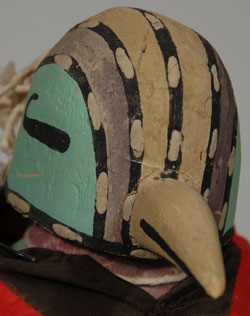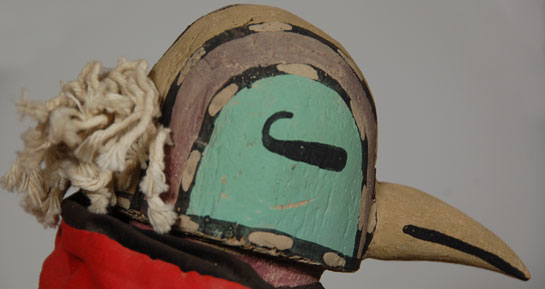Hopi Tsitoto (Flower) Katsina Doll [R]
+ Add to my watchlist Forward to Friend
Forward to Friend
- Category: Traditional
- Origin: Hopi Pueblo, Hopituh Shi-nu-mu
- Medium: cottonwood root, mineral paint, yarn
- Size: Very Tall: 21-5/8”
- Item # C3325A
- Price No Longer Available
 Among the Hopi, Tsitoto is an ancient Katsina known at all three mesas. He can be seen in the Palölökong Ceremony and at the Mixed Katsina dances, the Powamu Ceremony and Pachavu Ceremony. His appearance at all these ceremonies may be due to his having been around for such a long time. The bird-like appearance does not seem to tie him to a bird of any sorts but is just the character of his face. He traditionally wears a woman's manta as shown in this carving.
Among the Hopi, Tsitoto is an ancient Katsina known at all three mesas. He can be seen in the Palölökong Ceremony and at the Mixed Katsina dances, the Powamu Ceremony and Pachavu Ceremony. His appearance at all these ceremonies may be due to his having been around for such a long time. The bird-like appearance does not seem to tie him to a bird of any sorts but is just the character of his face. He traditionally wears a woman's manta as shown in this carving.
Jimmie Kootshongsie is best known by everyone as Jimmie Koots. He was born at the Third Mesa village of Hotevilla during the period of World War I. At a very young age, he and many other Hopi children were removed from their homes and taken to government schools where they were to be stripped of their Hopi beliefs and heritage and assimilated into the White Man's culture. Koots survived the five long years at the Bureau of Indian Affairs school and then returned to his native village.
At age 22, Koots was again taken away from his native village and sent off to the Pacific to fight in World War II. Following this war, he once again returned to the village of Hotevilla. It was then that he discovered that the big oil companies and the government were colluding to remove the Hopi from their reservation because of the wealth of mineral resources—coal, gas, oil and Uranium. He became an activist against strip mining and the big corporations. The Hopi retained their Native land (Hopi Indian Reservation).
Koots was among a group of Hopi who revived the ancient art of traditional Hopi Pueblo Katsina carvings. He was immensely popular in the 1960s and 1970s as a katsina doll carver. His dolls were mostly sold in Santa Fe at a downtown shop called Rare Things by Dutton, a business that is now closed but was very active in the 1960s-1980s. His carvings, although not signed, are so distinctive in appearance that they can be easily identified as his work. That is the case with this Tsitoto Katsina. It is distinctively the work of Jimmie Kootshongsie.
The carving is wood, with additional items added such as the fabric woman's manta, a wood cane wrapped in yarn in his left hand and a wood bell hanging from yarn in his right hand. Yarn ties are wrapped on his wrists and legs and a bundle of cotton string hangs behind the head. A metal stand has been fabricated for the doll to provide stability.
Condition: very good condition
Provenance: from the collection of a Santa Fe resident. The owner had it appraised in 1990 by Santa Fe dealer Rex Arrowsmith, so we know it was in her possession before that date.

- Category: Traditional
- Origin: Hopi Pueblo, Hopituh Shi-nu-mu
- Medium: cottonwood root, mineral paint, yarn
- Size: Very Tall: 21-5/8”
- Item # C3325A
- Price No Longer Available



